
|
|
 |

|


|
Samsung HW-F850 Review
Bluetooth Enabled 2.1 Sound Bar w/Subwoofer, $1299
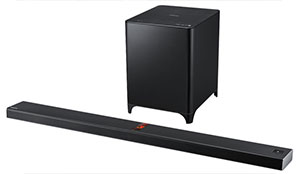
Dick De Jong Introduction
One of the harsh realities of today's sleek HDTVs is that their integrated speakers simply do not possess the power or space to generate audio comparable to the high definition picture. If you are not ready to commit to the expense and installation of a dedicated audio system like a multi-speaker (5.1, 7.1 or even 9.2 + AV receiver) surround system, then a sound bar, especially with a powered subwoofer, often proves to be a worthy solution. The HW-F850 is the top of Samsung's 2014 line of sound bars. At first glance, three aspects stand out. First, at over 46 inches, the F850 is one of the longest units in the marketplace and was designed to complement bigger (over 60-inch) HDTVs. 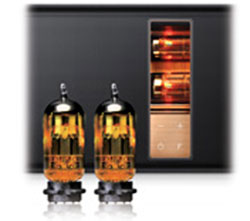
Second, in the middle of the bar is a little window that displays two glowing vacuum tubes, which are included in the pre-amp to give the HW-F850 a warmer, more natural, quality. What is less apparent about the HW-F850 are the connectivity options that make this sound bar much more than just a TV audio system. Most importantly, this unit is Bluetooth capable, which allows it to communicate with all your Bluetooth enabled smartphones, phablets, tablets and plain old computers. In seconds, I paired my iPad with this sound bar and was streaming music through to its excellent speakers. Finally, I did a double take when I first saw that this sound bar + subwoofer retails for $1299, (currently Samsung is offering it on their site for $999), which definitely places the HW-F850 in the upper stratosphere. But when I set it up (with its numerous connectivity options) and then witnessed its audio quality, I began to appreciate its value. If you don't need a sound bar as big or powerful but with many of the same features (including the vacuum tubes), then consider the Samsung HW-F750 at $949 (currently reduced to $599). Out of the Box
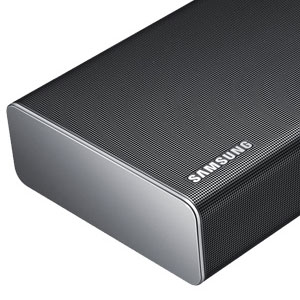
Beyond the glowing vacuum tubes, the Samsung HW-F850 is fairly nondescript - as you would hope since you don't need the sound bar distracting your eyes from the TV. The front and bottom are encased in a matte black perforated grille. The top and back sport a glossy black surface. The wireless subwoofer's brushed black façade is more subdued. Inside the sound bar are six two-way speakers (three on each side) made with Carbon Nano Tube material. The unit contains an auto gyro. Depending on how you mount the sound bar, the gyro will direct the sound either out the front (if mounted on a wall) or the bottom (if the sound bar is laid flat, like in the image below). 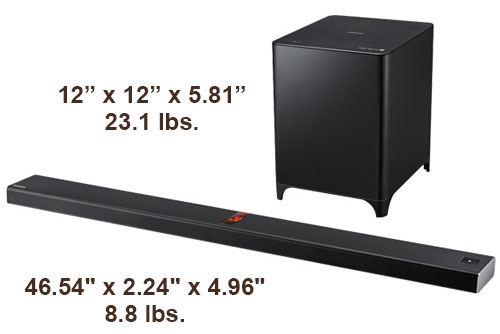 The 150W powered eight-inch subwoofer connects to the 200W sound bar wirelessly. The two are paired out of the box. Of course, the subwoofer still needs to be plugged in to a wall outlet for power. The manual states, "The transmission distance of the wireless signal between the main unit and subwoofer is about 33 ft., but may vary depending on your operating environment." It also cautions, "If you use a device that uses the same frequency (2.4GHz) as the unit near the unit, interference may cause some sound interruption." 
On the front of the sound bar, below the vacuum tube window is a touch panel with basic, volume, power and function buttons. On the right end is an NFC (Near Field Communication) tag, which you can tap with NFC enabled devices to perform a Bluetooth pairing. When I first read about the sound bar's display, I was puzzled because the traditional LCD panel was nowhere to be found. Once I powered the unit and started playing with the remote, I noticed the display, on the front next to the vacuum tubes, appear through the meshed grille. If you position the sound bar flat on its back, then the front display disappears and a second display on the bottom of the bar turns on. On the back is the audio connection panel, which includes one Optical Digital Audio In (S/PDIF), one one Analog Audio In (3.5mm stereo mini-jack), and one HDMI In and one HDMI out. In addition, an input for the ASC (Auto Sound Calibration) microphone is located on the back. On the top of the sound bar is a USB port for connecting USB devices such as MP3 players and flash drives. 
The rather large (1.75" x 6.75"), backlit, brushed black remote control is packed with buttons including convenient dedicated ones for selecting Input sources, like USB and Bluetooth. It also provides individual buttons for choosing the sound bar's Sound Effects, like Cinema or Music. And there are separate controls for adjusting the subwoofer's volume. With the VT Dimmer button, you can even control the brightness of the vacuum tubes' display. Setup
If your TV is mounted on the wall, then the sound bar is usually mounted right under it. Except for concealing the wires, the procedure is straightforward. But if your TV is sitting on its stand, then setting the sound bar next to it can be problematic because the unit may block the bottom part of the TV screen, which definitely could be the case with the HW-F850's five-inch height. Even if the screen clears the sound bar, the TV's IR window that receives the TV's remote control signals maybe obstructed. The Samsung designers have solved that issue by giving this sound bar the ability to work either upright or lying flat in front of the TV stand. When flat, the sound bar is a little over two inches tall, which should be low enough to clear the screen and not impede the remote's operation. As for locating the wireless subwoofer, you need to stay within the suggested 33-foot range and near a power outlet. The only other advice the manual gives is "For optimal listening performance, make sure that the area around the wireless subwoofer location is clear of any obstructions." As mentioned the subwoofer should be paired with the sound bar out of the box. If they get decoupled, the manual explains how to re-pair them. Next, you need to connect the TV to the sound bar. If you are lucky enough to own a Samsung TV that has the Soundshare feature (available with select 2012 and 2013 models), you can link the TV to the sound bar wirelessly through Bluetooth. With this system all of the connections from devices like set top boxes and Blu-ray players go directly to the TV and then the audio is sent from the TV to the sound bar wirelessly. It's an elegant solution. With Soundshare you will need to pair your TV and sound bar manually. The procedure did not work for me the first time. I had to reset the sound bar's Soundshare and then the two units linked. If your TV is not Soundshare enabled but does have an ARC (Audio Return Channel) HDMI, then you can run an HDMI cable from that HDMI connector to the HDMI In on the sound bar. Once again, the TV receives all the audio and visual signals from the set top devices and directs the audio to the HW-F850. If your TV is neither Soundshare nor ARC enabled but does have a digital audio output, then you can connect it to the sound bar's optical digital input. I prefer this method over the HDMI one because the optical digital cable is much smaller and easier to maneuver on the sound bar's input panel.  Samsung HW-850 Sound Bar's Connection Panel If your TV is neither Soundshare, ARC nor digital audio enabled, then you can run an analog audio cable between the TV and sound bar. It won't give you the greatest audio quality but it works. But wait, there's yet another possibility. You can connect a set top box directly to the sound bar with an HDMI cable. In this case, the sound bar is inputting both audio and video. It plays the audio and sends the video out through its HDMI Out and into the TV's HDMI In. This solution contains a couple of shortcomings. First, if your system has more than one HDMI source, like a set top box and a game console, then you will need some sort of switcher to select the source to send to the one HDMI In on the sound bar. In addition, if you think that wrangling one HDMI cable behind the sound bar is challenging, two cables can be gnarly, especially if you are planning to wall mount the unit. I realize the setup might sound more difficult than it actually is. Once you decide on a connection method, the procedure should only take a couple of minutes. 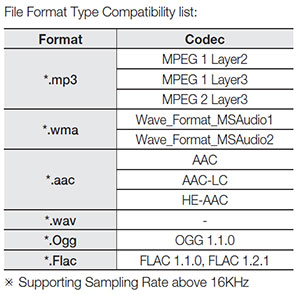
And Bluetooth pairing an iPad or an Android device to the sound bar often only takes seconds. (Remember that the recommended range for streaming between Bluetooth devices is about 33 feet.) And using an MP3 player or flash drive inserted in the USB port is plug and play. The HW-F850 sound bar does handle Dolby Digital and DTS audio signals, and the formats listed in the table. Performance
I just had a refresher listening session with the Samsung HW-F850 sound bar and I'm impressed with what I heard. A Samsung representative described the HW-F850's circuitry as a combination of "warmer sounding" vacuum tubes on the pre-amp side and a digital amp that provides "more detail and power." I'm not sure that my audio palate is refined enough to discern the subtleties of warmth, but I can definitely vouch for the definition and power. The sound bar does an admirable job of reproducing a clean, crisp rendition of orchestral music. Vital to TV speakers, dialogue is easy to hear and comprehend. As for power, the HW-F850 can churn out the decibels without distorting the sound, certainly enough volume to fill a 300 square foot room. And during a particularly deep bass moment in an action movie, the rumbling 150W subwoofer will massage your cheeks. As to be expected, since this sound bar system does not include satellite speakers, it really cannot recreate the true surround sound experience. Samsung includes a 3D Sound Plus feature which attempts to add "depth and spaciousness" to the sound. Just don't expect miracles. The designers have also incorporated six DSP Settings (movie, game, drama, music, news, sports) that are worth experimentation. Finally, you can perform some minor Tone tweaks on Treble, Middle and Bass. Value
At its reduced tag of $999 the Samsung HW-F850 is still pricey, putting the unit in the audiophile realm of sound bars. Comparing it to other sound bars in the marketplace, you are definitely paying a premium for the vacuum tube technology. With that said, if you are shopping for an excellent sounding, powerful sound bar + subwoofer combination to complement your over 60-inch HDTV, the HW-F850 is a worthy candidate. If you have a smaller sized TV but still relish the "warmth" of vacuum tubes, then consider the Samsung HW-750. 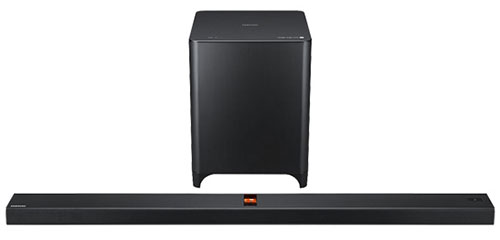 Conclusion
The Samsung HW-F850 46-inch Bluetooth enabled 2.1 sound bar with subwoofer supplies the power and audio quality to match the 60+ inch HDTVs that are becoming more prevalent in the marketplace. And with its multiple connectivity options, the unit can stream music from your phones, tablets or computers. |
Bookmark:
![]() del.icio.us
del.icio.us
![]() Reddit
Reddit
![]() Google
Google
| Send this Page | Print this Page | Report Errors |

